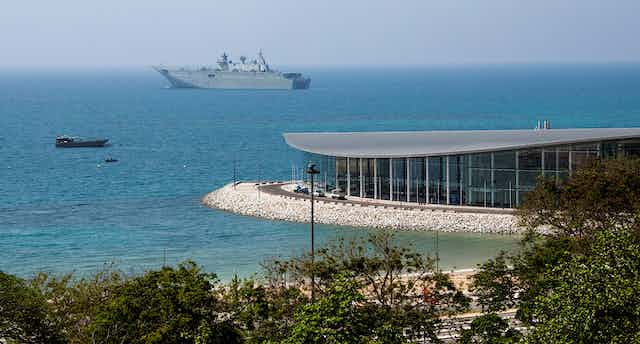The South Pacific region is a new battleground between the United States (US) and China. The region is home to 18 countries and territories, many of whom are small island developing states. For long, the US has been the most dominant power in the region. In fact, President Dwight D. Eisenhower had described it as the American lake. The region falls under the US’ Indo-Pacific Command and two of the closest American allies, Australia, and New Zealand, are located in the region. However, in the last few years, China’s growing footprint in the region’s economic and political affairs has been chipping away at the US influence.
From a strategic viewpoint, the most important and interconnected developments in the recent past have been the visit of China’s foreign minister Wang Yi to the region in May 2022 and the signing of a security co-operation agreement between China and the Solomon Islands. It is feared that the agreement will allow China to expand its security presence in the region. The Solomon Islands-China deal triggered alarm bells across the Indo-Pacific region including in the US, Australia, and India. As a result, the Quad summits since 2022 are paying attention to the South Pacific with each Quad country trying to expand their strategic presence in the region. Sensing the China challenge to its primacy, the US is now stepping up its game in the region.
Solomon Islands: Chinese FM Wang Yi says China’s security cooperation with Solomon Islands consistent with international lawhttps://t.co/QKKD9Qav9W pic.twitter.com/sG4ynZA8FQ
— Geoff Wade (@geoff_p_wade) June 5, 2022
On 28-29 September, the US organized the second leaders’ summit with the Pacific Island countries. The first summit was organized last year in September 2022 in response to the obvious challenge presented by China. The purpose of these summits is to strengthen the US’ ties with the South Pacific countries, demonstrate willingness to address the important concerns of these strategically important countries and counter the growing influence and presence of China. Therefore, the leaders’ statement issued after the summit focuses on issues such as climate change and disasters, climate resilience, developing fisheries and marine resources, enhancing trade and investment links, maintaining peace and security including the focus on illegal, unreported, and unregulated (IUU) fishing and ensuring people-centred development. In a veiled reference to China, the statement also notes that US and Pacific Island countries recognize “the rights and entitlements of all States under the international law of the sea as reflected in United Nations Convention on the Law of the Sea (UNCLOS)”.
The renewed US interest in the South Pacific is reflected in the fact that Washington is regularly dispatching senior officials to the region. Secretary of State Antony Blinken has visited the region thrice in three years and recently Samantha Power travelled to the region to open a new mission of the USAID in Fiji to support its activities in the South Pacific. In a developing region like the South Pacific, providing development support has strategic implications. Earlier this year, President Biden was expected to visit Papua New Guinea, however, he had to cancel his visit at the last minute due to the American domestic situation.
Meanwhile, in a visible display of growing strategic importance of the South Pacific, the US is on a spree of opening new diplomatic missions in the region. Since September 2022, it has opened embassies in Solomon Islands and Tonga. Next year, it plans to open missions in Vanuatu and Kiribati as well. Moreover, at this year’s summit, the US announced that it recognizes the independence of Cook Islands and Niue and will establish diplomatic relations with both. The augmenting of diplomatic presence is necessary to facilitate greater interaction and exchanges. As China is redoubling its efforts to wean away support for Taiwan from the Pacific Island countries, the enhanced US presence assumes strategic importance.
The US plans to set up embassies in the Pacific island countries of Tonga, Kiribati and Vanuatu respectively. The purpose of the US is obviously to safeguard its hegemonic rights and interests and enslave local countries for its own use. pic.twitter.com/lj1Nbb5Bns
— Merve Yılmaz (@MerveYllz) May 5, 2023
The Quad countries have launched the Indo-Pacific Partnership for Maritime Domain Awareness (IPMDA). Under the IPMDA, the US intends to provide $ 11.4 million to the IPMDA-Pacific pilot. It will help in bringing cutting-edge maritime domain awareness technology to the region and will also facilitate coordination on issues such as maritime law enforcement and information analysis. Moreover, the US has been training military officers from the region and increasing the presence of the US Coast Guard is also on the cards. Other efforts such as returning of the US Peace Corps to the region, building sister-city links, providing funds to strengthen cyber security capacity, increasing academic and work exchange opportunities for the people from the region are also likely to help the US to re-establish its presence in the region.
For long, the South Pacific was seen as a neglected region for world politics. However, in the last few years, the region is gaining increasing prominence due to the expansion of Chinese presence and its impact on the regional balance of power. As the US seeks to counter the growing China challenge, the role of other like-minded partners such as Australia, India, Japan and France will be critical.
(Sankalp Gurjar writes on International Relations of the Indo-Pacific, Great Power Politics, and the Geopolitics of the Indian Ocean Region. He is the author of The Superpowers’ Playground: Djibouti and Geopolitics in the Indo-Pacific in the 21st Century)




















